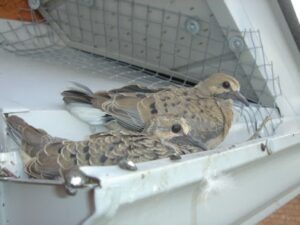Most homes are covered with perfect nesting sites for birds. Unless you’re looking to turn your home into a bird sanctuary, here are some easy ways to keep birds away. For effective bird removal, turn to our Milwaukee Skedaddle Humane Wildlife Control team for hassle-free removal and prevention strategies. Explore the many reasons that birds set up nests around your home and what you can do to prevent them.
How To Identify Ideal Nesting Areas
Most species of birds look for flat areas with minimal or no traffic to construct their nests. Nest sizes, shapes and constructions can vary dramatically. You may be surprised to see how many level surfaces there are on your home. Here are some nesting sites that are commonly found in homes and professional buildings:
- Ledges and nooks
- Roof peaks and eaves
- Lights
- Railings
- HVAC equipment and solar panels
Birds can bring all sorts of leaves, sticks and other debris to construct nests in these areas. Once a nest is built, it’s quickly populated with eggs and then babies. Removal and prevention are both very difficult at this stage, so work with a professional wildlife expert to solve the issue.
A bird nest may be a great sign of a thriving bird population, but on or around your home it can be hazardous. Some nesting sites, like around HVAC equipment or chimneys, can be dangerous for the birds and your property. Other locations can cause bird droppings and debris to build up around your home, which could be a health issue for you and your loved ones.
How To Keep Birds Away
You can prevent these issues with quality prevention tips and techniques. The most effective deterrents are simply to remove any convenient nesting area so local birds will find other suitable locations to build their nests. Have a professional help you seal up any holes around your house. Most residences are reasonably sealed, but damaged eaves and other areas of your home may provide ideal nesting sites for birds. Repairing holes, covering up air vents and other maintenance steps can encourage birds to move somewhere else for their new nest.
Bird netting, spikes and steel screening are helpful wildlife exclusion measures. Take care to set these up while there are no current nests around. These materials are designed to prevent access to a nesting site, but trapping an occupied nest behind the barrier is an inhumane way to deal with birds.
If you see a nest being built, it may not be too late. Don’t attempt to handle wildlife or a nest on your own, as some birds are quite territorial. Contact a professional wildlife team to see if there’s a way to gently move the nest or destroy the partial nest. A partial nest isn’t a shelter for birds or eggs, so the bird will simply create a new nest in another area.

Strong smells may be an effective way to keep birds away as well. Ask a local wildlife expert about using peppermint oil and citronella to discourage nesting, as these smells often deter certain types of critters and birds. Other measures may not work as well. Fake owls, noises and other barrier-free prevention strategies are only short-term solutions. Birds are intelligent enough to realize these tactics aren’t true threats, and they quickly learn to ignore them. Discuss any prevention method with a trained wildlife expert before attempting it to ensure you choose an effective, compassionate option.
Contact Skedaddle in Milwaukee Today
Take care of birds and nests the humane way. Contact Skedaddle today to learn more about how to keep birds away from your home. Ask a qualified professional to inspect your property and install fencing, screening and spikes in areas to deter nests.


